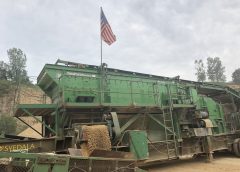McLanahan Corp.’s H-Series MAX triple-shaft horizontal screen offers the latest in screen technology. It can be used in both portable or fixed plant applications. Horizontal screens provide high G-forces to vibrate and move material down the length of the screen.
A primary feature of the H-Series MAX Screen is its aggressive action in applications where blinding or plugging of the screen media openings can occur. The horizontal screen provides producers with unmatched performance and cost-saving features.
The H-Series MAX screen features fully adjustable oval stroke technology to create advantages that will positively impact profitability.
McLanahan’s H-Series MAX horizontal screens are designed to match the level of durability required for the mining and aggregate industries. Weld-free, high-strength steel side plates, laminated in all high-stress areas, coupled with reinforced deck frames combine to create a screen basket assembly with significant strength and durability.
Reinforcing straps provide added side plate strength for side-tensioning media. The drive guard and snubbers are strategically designed and located for improved access to tension bolts.
The triple-shaft mechanism allows for the flow-through lubrication common to oval stroke vibrators, but also features a unique means to retain oil in the bearings at shutdown (patent pending). There are no dry bearing start-ups that drive the life out of bearings, particularly in harsh weather.
The H-Series MAX triple-shaft screens can match the footprint of many screens on the market today, allowing for easy retrofitting on existing plants. Compared to linear stroke screens, the oval stroke with the elliptical characteristic offers unmatched efficiency by maintaining open areas and the ability to fine-tune the screen to better suit the application.
Horizontal screens, with triple-shaft mechanisms, typically offer better efficiency and more accurate particle sizing compared to inclined screens because the material is retained on the screen longer, with a slower travel rate to the end of the screen. This allows more properly sized material to fall through the screen openings.
In a stationary plant setup, horizontal screens are more often seen as tertiary and/or finishing screens. Horizontal screens are also popular on portable plants because of their low profile.

